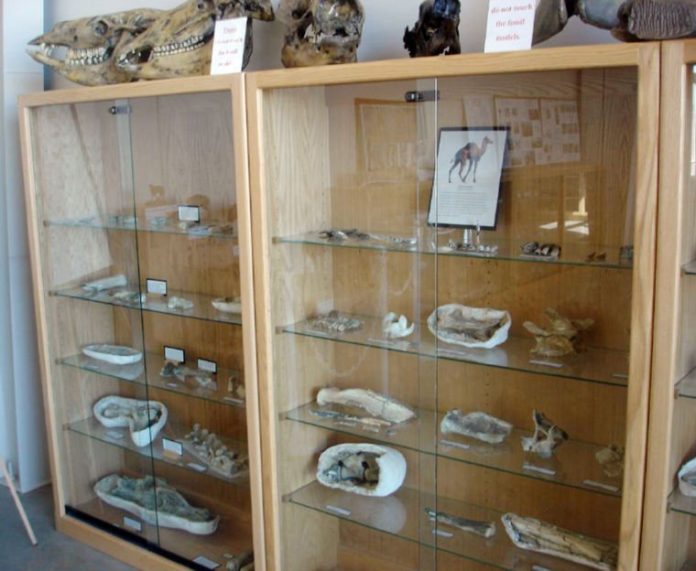If you haven’t driven the Pacheco Pass Highway to the Central Valley lately, you are in for a pleasant surprise. You can enjoy the lovely green hills on this side of the pass while also carefully watching the huge trucks passing each other on the upgrade at 35 and 40 mph. Beyond the San Luis Reservoir and Los Banos, you are almost back in America’s Midwest flatland farm country. Mile after mile of crops, fruit trees and an occasional goat or alpaca farm spread out on both sides of the highway. Old Glory flutters every few miles and the radio stations morph into religious programs or conservative talk shows. A road sign says it all: Indiana Avenue.
Shortly after merging onto Highway 99 south at Avenue 21 1/2 (Exit 164), you’ll find an interesting exhibition center: The San Joaquin Valley Paleontology Foundation’s Fossil Discovery Center, also known as the Fairmead fossil site. Located across the street from what archeologists call a “midden” – but often referred to as the county dump – this site is the largest fossil recovery site in the United States.
More than 15,000 fossils from 37 species have been recovered from the site to date, and California State University Fresno archeologists plan on 20 more years of active digging. The fossils range between 500,000 and 780,000 years old – the Middle Pleistocene Epoch, which lasted from 1.8 million years ago to until about 10,000 years ago.
As I walked from the parking lot past a covered “mock” dig, some children were eagerly digging up “fossil” bones. Staff held books with photographs to help the kids identify what they had dug up.
Blake, one of the staff members, walked with me into the center and explained the procedure: Visitors are asked to view an eight minute film in the theater showing how the center came into existence. Afterward, it is easy to follow the exhibits from each scene or topic to another.
I was lucky enough to join a class of first- and fourth-graders from Terry Elementary School in Selma. As the students were led on the tour by Betty, a staff member, their teacher said the fourth-graders had tutored the younger students all year – and this was the end of the school-year treat.
As you enter the main hall, the first thing you see is a replica of a gigantic California mammoth standing about 14-feet tall at the shoulder. In 1993, a landfill employee found a tusk from a California mammoth 35-feet below the surface, and that find began the whole dig.
At the back of the museum sat an archeological work table with a variety of tools and a sample plaster-coated burlap jacket in which fossils are carefully preserved upon recovery.
We found out that the most common animal remains found are from various types of horses. Camelops, an archetypical camel – which may or may not have had a hump – was also prevalent, along with many other forerunners of today’s animals. Larger than today’s camels, the camelop was about 7-feet tall and weighed up to 2,600 pounds.
The preparation laboratory, where archeologists prepare fossils for display, is a well-done exhibit showing how archeologists identify and classify remains. Staff member Linda showed us a variety of tiny remains and asked the children to identify them. With her help, they were able to recognize an ancient snail shell and a rodent. A small blue tooth, which was not readily identifiable, was classified as random unidentifiable objects.
In front of the lab was a taphonomy exhibit, which shows a study of organisms and how they decay over time and become fossilized. But the kids and I were more interested in the back wall, which had cast skeletons of ice age animals, including a saber-toothed cat, dire wolf, giant ground sloth and short face bear. We found out that the saber-toothed cat or Smilodon is the official state fossil of California – who knew?
Outside, a Pleistocene Water Source (waterhole or pond to us) has been constructed. This water hole and lush native vegetation reflects how this area appeared some 700,000 years ago – very different from today’s semi-arid climate. For those interested in plants, there is a leaflet at the entrance describing the various ancient plants replicated in the pond area.
This museum, while small, is extremely interesting and especially geared to introduce children to paleontology/archeology. The contrast of what this area was like in prehistoric times compared to today’s farmlands is rather staggering. It is certainly worth a visit.
Edita McQuary has a bachelor’s degree cum laude in English literature from College of Notre Dame in Belmont and works as a newsletter editor for a church in Aptos. She is an archeology aficionada. Jessica, her 13-year-old granddaughter, shares that interest, and Payton, her 5-year-old grandson, wants to be a fireman but likes to dig in the sand.













